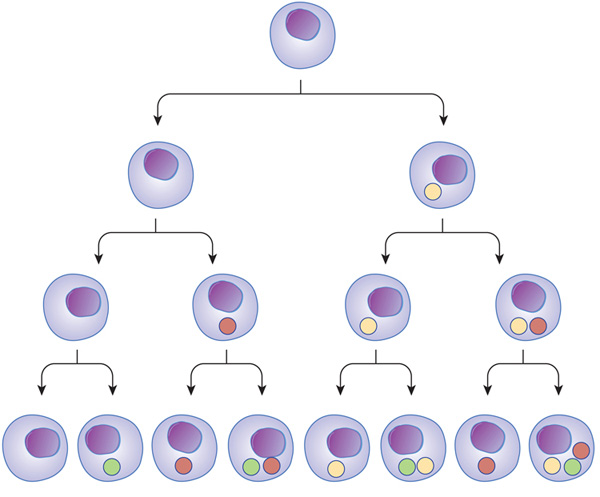Most cells of the fetus undergo a specialization process called differentiation. Cell differentiation augments specific cytoplasmic activities for functions at the level of tissues and organs.
Cells predominantly express sets of genes that mediate specific cytoplasmic activities, becoming efficiently organized in tissues with specialized functions and usually changing their shape accordingly.
For example, muscle cell precursors elongate into long, fiber-like cells containing large arrays of actin and myosin. All animal cells contain actin filaments and myosins, but muscle cells are specialized for using these proteins to convert chemical energy into forceful contractions.
Differentiated cells typically specialize in one activity.
| General Cellular Activity | Specialized Cell(s) |
|---|---|
| Movement | Muscle and other contractile cells |
| Form adhesive and tight junctions between cells | Epithelial cells |
| Synthesize and secrete components of the extracellular matrix | Fibroblasts, cells of bone and cartilage |
| Convert physical and chemical stimuli into action potentials | Neurons and sensory cells |
| Synthesis and secretion of degradative enzymes | Cells of digestive glands |
| Synthesis and secretion of glycoproteins | Cells of mucous glands |
| Synthesis and secretion of steroids | Certain cells of the adrenal gland, testis, and ovary |
| Ion transport | Cells of the kidney and salivary gland ducts |
| Intracellular digestion | Macrophages and neutrophils |
| Lipid storage | Fat cells |
| Metabolite absorption | Cells lining the intestine |
It is important to understand that the functions listed there can be performed by most cells of the body; specialized cells have greatly expanded their capacity for one or more of these functions during differentiation. Changes in cells’ microenvironments under normal and pathologic conditions can cause the same cell type to have variable features and activities. Cells that appear similar structurally often have different families of receptors for signaling molecules such as hormones and extracellular matrix (ECM) components, causing them to behave differently. For example, because of their diverse arrays of receptors, breast fibroblasts and uterine smooth muscle cells are exceptionally sensitive to female sex hormones, while most other fibroblasts and smooth muscle cells are insensitive.
The process by which differentiated cells create tissues and organs is called pattern formation. To form tissues, cells must exhibit intercellular recognition and communication, adhesion, and memory. Specialized cells sense their environment through signals, such as growth factors, from other cells. This type of communication ensures that new cells are produced only when and where they are required. Different cell types have different adhesion molecules in their plasma membranes, sticking selectively to other cells of the same type. They can also adhere to extracellular matrix components. Cells have memory becasue of specialized patterns of gene expression evoked by signals that acted during embyonic development. Memory allows cells to autonomously preserve their distinctive character and pass it on to their progeny.
Intercellular Communication
Cells in direct physical contact with neighboring cells are often linked have specialized plasma membrane regions called cell junctions. Cell junctions have to main functions (1) to hold cells together and (2) to allow small molecules to pass from cell to cell, allowing coordination of the activities of cells that form tissues.
All tissues in the body are composed of 1)parenchymal cells, which are specialized to perform the functions of that particular tissue, and 2) extracellular matrix, which act as the supporting framework of the tissue. This matrix not only holds cells and tissues together but also provides an organized latticework within which cells can migrate and interact with one another.
The three main types of cell junctions are (1) desmosomes (macula adherens), (2) tight junctions (zonula occludens), and (3) gap junctions.
Reference
1. http://www.nature.com/nature/journal/v493/n7432/fig_tab/nature11859_F1.html
The process of differentiation leads to production of the effectors of tissue function: mature cells. Without proper differentiation, the integrity of tissue function would be compromised and organ failure or neoplasia would ensue.
Signature characteristics of the stem cell. Stem cells have two essential features: the capacity to differentiate into a variety of mature cell types and the capacity for self-renewal.
Intrinsic factors associated with self-renewal include expression of Bmi-1, Gfi-1, PTEN, STAT5, Tel/Atv6, p21, p18, MCL-1, Mel-18, RAE28, and HoxB4. Extrinsic signals for self-renewal include Notch, Wnt, SHH, angiogenin, and Tie2/Ang-1.
Based mainly on murine studies, hematopoietic stem cells express the following cell surface molecules: CD34, Thy-1 (CD90), c-Kit receptor (CD117), CD133, CD164, and c-Mpl (CD110, also known as the thrombopoietin receptor).
Tissues maintain stem cells to serve as a reservoir of undifferentiated cells. Stem cells typically have the capacity to mature into many different cell types. Transcription factors — proteins that regulate which genes are transcribed in a cell — appear to be essential to determining the pathway particular stem cells take as they differentiate. For example, both intestinal absorptive cells and goblet cells arise from the same stem cell population, but divergent transcriptional programs cause them to mature into dramatically different cells.
Whenever stem cells are called upon to generate a particular type of cell, they undergo an asymmetric cell division. With asymmetric division, each of the two resulting daughter cells has its own unique life course. In this case, one of the daughter cells has a finite capacity for cell division and begins to differentiate, whereas the other daughter cell remains a stem cell with unlimited proliferative ability.

+++++++++++++
Refinements in cell structure and function accompany embryonic and fetal development, maturation, aging, and death.

